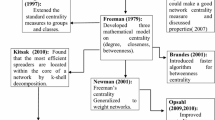Abstract
Data transmission in socially aware networks is usually accomplished through opportunistic peer-to-peer links in a storage-carry-forward way. This way demands nodes to actively participate in forwarding cooperation. However, several nodes display selfish behavior due to resource constraints and other factors, refusing to expend their own resources to aid in forwarding data, which will result in reduced network performance. Thus, a comprehensive confirmation-based selfish node detection algorithm(CCSDA) is proposed in this paper. First, the algorithm constructs a reputation evaluation model, which defines the node’s communication satisfaction and energy trust using the node’s historical communication behavior and energy consumption state and quantifies the node’s direct reputation value from several dimensions. Considering the existence of some edge nodes that are misjudged due to low cooperation opportunities for objective reasons, node centrality is introduced in the energy trust assessment to improve detection accuracy. Combining the direct reputation, indirect reputation based on neighbor sharing, and historical comprehensive reputation determines the final comprehensive reputation value to judge the nodes’ selfish attributes. Secondly, to reduce the additional energy consumption induced by the acknowledgment message mechanism in the reputation detection mechanism, a high reputation threshold is set. For high reputation nodes above this threshold, the node behavior will be monitored utilizing the interaction information-based detection mechanism to mitigate the energy consumption and thus optimize the network performance and monitor the confirmatory selfish behavior by combining communication satisfaction and energy trust. Finally, to reduce the performance impact of the misclassification of the normal nodes in the reputation detection mechanism, the nodes that are determined to be abnormal by the reputation detection mechanism are evaluated twice using the interaction information-based detection mechanism to improve the detection rate. The experimental outcomes demonstrate that the algorithm optimizes the detection performance and reduces the performance loss caused by selfish nodes compared with existing detection algorithms.










Similar content being viewed by others
Data Availability
Data available on request from the authors.
Code Availability
Code available on request from the authors.
References
Qiu, M., Ming, Z., et al. (2012). Three-phase time-aware energy minimization with dvfs and unrolling for chip multiprocessors. Journal of Systems Architecture, 58(10), 439–445.
Qiu, M., Li, H., & Sha, E. (2009). Heterogeneous real-time embedded software optimization considering hardware platform. In ACM Symposium on Applied Computing, pp. 1637–1641.
Li, J., et al. (2013). Thermal-aware task scheduling in 3D chip multiprocessor with real-time constrained workloads. ACM Transactions on Embedded Computing Systems (TECS), 12(2), 1–22.
Qiu, H., Zheng, Q., et al. (2020). Deep residual learning-based enhanced JPEG compression in the internet of things. IEEE Transactions on Industrial Informatics, 17(3), 2124–2133.
Tao, L., Golikov, S., et al. (2015). A reusable software component for integrated syntax and semantic validation for services computing. In IEEE Symposium on Service-Oriented System Engineering, pp. 127–132.
Qiu, H., Qiu, M., & Lu, R. (2019). Secure V2X communication network based on intelligent PKI and edge computing. IEEE Network, 34(2), 172–178.
Hu, F., Lakdawala, S., et al. (2009). Low-power, intelligent sensor hardware interface for medical data preprocessing. IEEE Transactions on Information Technology in Biomedicine, 13(4), 656–663.
Qiu, M., Guo, M., Liu, M., et al. (2009). Loop scheduling and bank type assignment for heterogeneous multi-bank memory. JPDC, 69, 546–558.
Qiu, H., Zeng, Y., et al. (2021). Deepsweep: An evaluation framework for mitigating DNN backdoor attacks using data augmentation. In ACM Asia Conference on Computer and Communication.
Xia, F., Liu, L., Li, J., Ma, J., & Vasilakos, A. V. (2015). Socially aware networking: a survey. IEEE Systems Journal, 9(3), 904–921.
Xiang, S., & Yang, J. (2018). Performance reliability evaluation for mobile ad hoc networks. Reliability Engineering & System Safety, 169, 32–39.
Pelusi, L., Passarella, A., & Conti, M. (2006). Opportunistic networking: Data forwarding in disconnected mobile ad hoc networks. IEEE Communications Magazine, 44(11), 134–141.
Ning, Z., Liu, L., Xia, F., Jedari, B., Lee, I., & Zhang, W. (2016). Cais: a copy adjustable incentive scheme in community-based socially aware networking. IEEE Transactions on Vehicular Technology, 66(4), 3406–3419.
Bisio, I., Lavagetto, F., Sciarrone, A., Penner, T., & Guirguis, M. (2017). Context-awareness over transient cloud in D2D networks: Energy performance analysis and evaluation. Transactions on Emerging Telecommunications Technologies, 28(2), e3002.
Fall, K., & Farrell, S. (2008). DTN: an architectural retrospective. IEEE Journal on Selected Areas in Communications, 26(5), 828–836.
Xia, F., Liu, L., Li, J., Ahmed, A. M., Yang, L. T., & Ma, J. (2014). Beeinfo: Interest-based forwarding using artificial bee colony for socially aware networking. IEEE Transactions on Vehicular Technology, 64(3), 1188–1200.
Bocquillon, R., & Jouglet, A. (2018). Robust routing in deterministic delay-tolerant networks. Computers & Operations Research, 92, 77–86.
Jia, W., Chen, Z., & Zhao, M. (2019). Weight distribution and community reconstitution based on communities communications in social opportunistic networks. Peer-to-Peer Networking and Applications, 12, 158–166.
He, Z., Pan, D., Lv, J., & Song, H. (2017). Survey of research on node’s selfish behavior in opportunistic networks. Computer Engineering and Applications, 53(18), 7–16.
Socievole, A., De Rango, F., Caputo, A., & Marano, S. (2016). Simulating node selfishness in opportunistic networks. pp. 1–6.
Li, Y., Guolong, S., & Wang, Z. (2012). Evaluating the effects of node cooperation on dtn routing. AEU-International Journal of Electronics and Communications, 66(1), 62–67.
Vahdat, A., Becker, D., et al. (2000). Epidemic routing for partially connected ad hoc networks. Technical Report CS-200006, Duke University.
Xiao, X. F., Li, Y., Kui, X., & Vasilakos, A. V. (2014). Assessing the influence of selfishness on the system performance of gossip based vehicular networks. Wireless Networks, 20, 1795–1805.
Wu, Y., Huang, H., Deng, S., & Dai, C. (2015). Performance of two-hop routing in delay tolerant networks with selfish nodes. In 2015 IEEE Symposium on Computers and Communication (ISCC), pp. 58–63. IEEE.
Ma, X. B., Zheng, T. Y., & Li, M. Z. (2019). Analysis and regulation of effects of selfishness on opportunistic network. Acta Electonica Sinica, 47(4), 837.
Loudari, S. E., & Benamar, N. (2019). Effects of selfishness on the energy consumption in opportunistic networks: a performance assessment. pp. 1–7.
Wang, R., Wang, Z., Ma, W., Deng, S. U., & Huang, H. (2019). Epidemic routing performance in dtn with selfish nodes. IEEE Access, 7, 65560–65568.
Qiu, M., Xue, C., Shao, Z., et al. (2006). Efficient algorithm of energy minimization for heterogeneous wireless sensor network. In IEEE EUC Conference, pp. 25–34.
Niu, J., Gao, Y., Qiu, M., & Ming, Z. (2012). Selecting proper wireless network interfaces for user experience enhancement with guaranteed probability. JPDC, 72(12), 1565–1575.
Qiu, M., Xue, C., Shao, Z., & Sha, E. (2007). Energy minimization with soft real-time and dvs for uniprocessor and multiprocessor embedded systems. In IEEE DATE Conference, pp. 1–6.
Qiu, M., Jia, Z., Xue, C., Shao, Z., & Sha, E. (2007). Voltage assignment with guaranteed probability satisfying timing constraint for real-time multiproceesor DSP. Journal of VLSI Signal Processing Systems.
Li, J., Ming, Z., et al. (2011). Resource allocation robustness in multi-core embedded systems with inaccurate information. Journal of Systems Architecture, 57(9), 840–849.
Qiu, M., Yang, L., Shao, Z., & Sha, E. (2009). Dynamic and leakage energy minimization with soft real-time loop scheduling and voltage assignment. IEEE TVLSI, 18(3), 501–504.
Xiao, N., Xinyi, R., Xiong, Z., Fang, X., Zhang, X., Qiong, X., Zhao, X., & Ye, C. (2021). A diversity-based selfish node detection algorithm for socially aware networking. Journal of Signal Processing Systems, 93(7), 811–825.
Marti, S., Giuli, T. J., Lai, K., & Baker, M. (2000). Mitigating routing misbehavior in mobile ad hoc networks. pp. 255–265.
Hernandez-Orallo, E., Olmos, M. D. S., Cano, J. C., Calafate, C. T., & Manzoni, P. (2014). Cocowa: a collaborative contact-based watchdog for detecting selfish nodes (vol. 14, pp. 1162–1175). IEEE.
Hernández-Orallo, E., Olmos, M. D. S., Cano, J. C., Calafate, C. T., & Manzoni, P. (2014). A fast model for evaluating the detection of selfish nodes using a collaborative approach in manets. Wireless Personal Communications, 74, 1099–1116.
Balakrishnan, K., Deng, J., & Varshney, V. K. (2005). Twoack: Preventing selfishness in mobile ad hoc networks. 4, 2137–2142.
Senthilkumar, S., & William, J. (2014). A survey on reputation based selfish node detection techniques in mobile ad hoc network. Journal of Theoretical and Applied Information Technology, 60, 208–215.
Liu, K., Deng, J., Varshney, P. K., & Balakrishnan, K. (2007). An acknowledgment-based approach for the detection of routing misbehavior in manets. IEEE Transactions on Mobile Computing, 6(5), 536–550.
Bigwood, G.., & Henderson, T. (2011). Ironman: Using social networks to add incentives and reputation to opportunistic networks. pp. 65–72.
Ciobanu, R. I., Dobre, C., Dascălu, M., Trăuşan-Matu, Ş, & Cristea, V. (2014). Sense: A collaborative selfish node detection and incentive mechanism for opportunistic networks. Journal of Network and Computer Applications, 41, 240–249.
Li, J. B., Chen, Q. B., Ren, Z., & Tan, Y. Y. (2016). Reliable selfish node detection algorithm for opportunistic networks. Journal on Communications, 37(3), 1.
Michiardi, P., & Molva, R. (2002). Core: a collaborative reputation mechanism to enforce node cooperation in mobile ad hoc networks. pp. 107–121.
Fayaz, M., Mehmood, G., Khan, A., Abbas, S., Fayaz, M., & Gwak, J. (2022). Counteracting selfish nodes using reputation based system in mobile ad hoc networks (vol. 11, p. 185). MDPI.
Dias, J. A., Rodrigues, J. J., Xia, F., & Mavromoustakis, C. X. (2015). A cooperative watchdog system to detect misbehavior nodes in vehicular delay-tolerant networks. IEEE Transactions on Industrial Electronics, 62(12), 7929–7937.
Li, N., & Das, S. K. (2010). Radon: Reputation-assisted data forwarding in opportunistic networks. pp. 8–14.
Keränen, A., Ott, J., & Kärkkäinen, T. (2009). The one simulator for dtn protocol evaluation. In Proceedings of the 2nd International Conference on Simulation Tools and Techniques, pp. 1–10.
Spyropoulos, T., Psounis, K., & Raghavendra, C. S. (2005). Spray and wait: an efficient routing scheme for intermittently connected mobile networks. In Proceedings of the 2005 ACM SIGCOMM Workshop on Delay-tolerant Networking, pp. 252–259.
Acknowledgements
This work was partially supported by the National Natural Science Foundation of China (No.61972136), and Hubei Natural Science Foundation (No.2020CFB497, No.2020CFB571), the Hubei Provincial Department of Education Outstanding Youth Scientific Innovation Team Support Foundation (No.T201410, T2020017), the Science and Technology Research Projects of Hubei Provincial Department of Education (No.Q20162706),the Natural Science Foundation of Xiaogan City (XGKJ2022010095).
Funding
This paper was partially supported by the National Natural Science Foundation of China (No.61972136) and Hubei Natural Science Foundation (No.2020CFB497, No.2020CFB571), the Hubei Provincial Department of Education Outstanding Youth Scientific Innovation Team Support Foundation (No.T201410, T2020017), the Science and Technology Research Projects of Hubei Provincial Department of Education (No.Q20162706),the Natural Science Foundation of Xiaogan City (XGKJ2022010095).
Author information
Authors and Affiliations
Contributions
Zenggang Xiong: Supervision, Conceptualization, Methodology, Writing - Review & Editing. Xiang Li: Software, Validation, Formal analysis, Writing - Original Draft, Visualization. Xuemin Zhang: Project administration, Conceptualization. Min Deng: Methodology, Formal analysis. Fang Xu: Visualization, Writing - Review & Editing. Bin Zhou: algorithm implementation, Writing - Review & Editing. Minyang Zeng: Simulation, algorithm implementation.
Corresponding author
Ethics declarations
Ethical Approval
For this type of study formal consent was not required. This manuscript does not contain any studies with human participants or animals performed by any of the authors.
Conflict of Interest
The authors have no conflicts of interest to declare for this manuscript.
Additional information
Publisher's Note
Springer Nature remains neutral with regard to jurisdictional claims in published maps and institutional affiliations.
This article is part of the Topical Collection on Big Data Security Track
Rights and permissions
Springer Nature or its licensor (e.g. a society or other partner) holds exclusive rights to this article under a publishing agreement with the author(s) or other rightsholder(s); author self-archiving of the accepted manuscript version of this article is solely governed by the terms of such publishing agreement and applicable law.
About this article
Cite this article
Xiong, Z., Li, X., Zhang, X. et al. A Comprehensive Confirmation-based Selfish Node Detection Algorithm for Socially Aware Networks. J Sign Process Syst 95, 1371–1389 (2023). https://doi.org/10.1007/s11265-023-01868-6
Received:
Revised:
Accepted:
Published:
Issue Date:
DOI: https://doi.org/10.1007/s11265-023-01868-6




